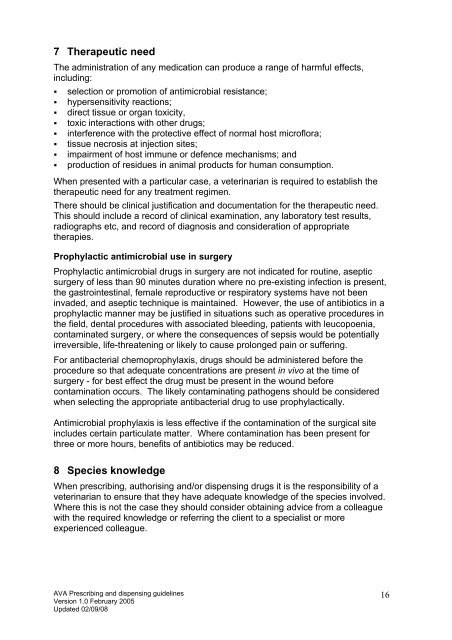Guidelines for Prescribing, Authorising and Dispensing - Australian ...
Guidelines for Prescribing, Authorising and Dispensing - Australian ...
Guidelines for Prescribing, Authorising and Dispensing - Australian ...
You also want an ePaper? Increase the reach of your titles
YUMPU automatically turns print PDFs into web optimized ePapers that Google loves.
7 Therapeutic need<br />
The administration of any medication can produce a range of harmful effects,<br />
including:<br />
� selection or promotion of antimicrobial resistance;<br />
� hypersensitivity reactions;<br />
� direct tissue or organ toxicity,<br />
� toxic interactions with other drugs;<br />
� interference with the protective effect of normal host microflora;<br />
� tissue necrosis at injection sites;<br />
� impairment of host immune or defence mechanisms; <strong>and</strong><br />
� production of residues in animal products <strong>for</strong> human consumption.<br />
When presented with a particular case, a veterinarian is required to establish the<br />
therapeutic need <strong>for</strong> any treatment regimen.<br />
There should be clinical justification <strong>and</strong> documentation <strong>for</strong> the therapeutic need.<br />
This should include a record of clinical examination, any laboratory test results,<br />
radiographs etc, <strong>and</strong> record of diagnosis <strong>and</strong> consideration of appropriate<br />
therapies.<br />
Prophylactic antimicrobial use in surgery<br />
Prophylactic antimicrobial drugs in surgery are not indicated <strong>for</strong> routine, aseptic<br />
surgery of less than 90 minutes duration where no pre-existing infection is present,<br />
the gastrointestinal, female reproductive or respiratory systems have not been<br />
invaded, <strong>and</strong> aseptic technique is maintained. However, the use of antibiotics in a<br />
prophylactic manner may be justified in situations such as operative procedures in<br />
the field, dental procedures with associated bleeding, patients with leucopoenia,<br />
contaminated surgery, or where the consequences of sepsis would be potentially<br />
irreversible, life-threatening or likely to cause prolonged pain or suffering.<br />
For antibacterial chemoprophylaxis, drugs should be administered be<strong>for</strong>e the<br />
procedure so that adequate concentrations are present in vivo at the time of<br />
surgery - <strong>for</strong> best effect the drug must be present in the wound be<strong>for</strong>e<br />
contamination occurs. The likely contaminating pathogens should be considered<br />
when selecting the appropriate antibacterial drug to use prophylactically.<br />
Antimicrobial prophylaxis is less effective if the contamination of the surgical site<br />
includes certain particulate matter. Where contamination has been present <strong>for</strong><br />
three or more hours, benefits of antibiotics may be reduced.<br />
8 Species knowledge<br />
When prescribing, authorising <strong>and</strong>/or dispensing drugs it is the responsibility of a<br />
veterinarian to ensure that they have adequate knowledge of the species involved.<br />
Where this is not the case they should consider obtaining advice from a colleague<br />
with the required knowledge or referring the client to a specialist or more<br />
experienced colleague.<br />
AVA <strong>Prescribing</strong> <strong>and</strong> dispensing guidelines<br />
Version 1.0 February 2005<br />
Updated 02/09/08<br />
16

















